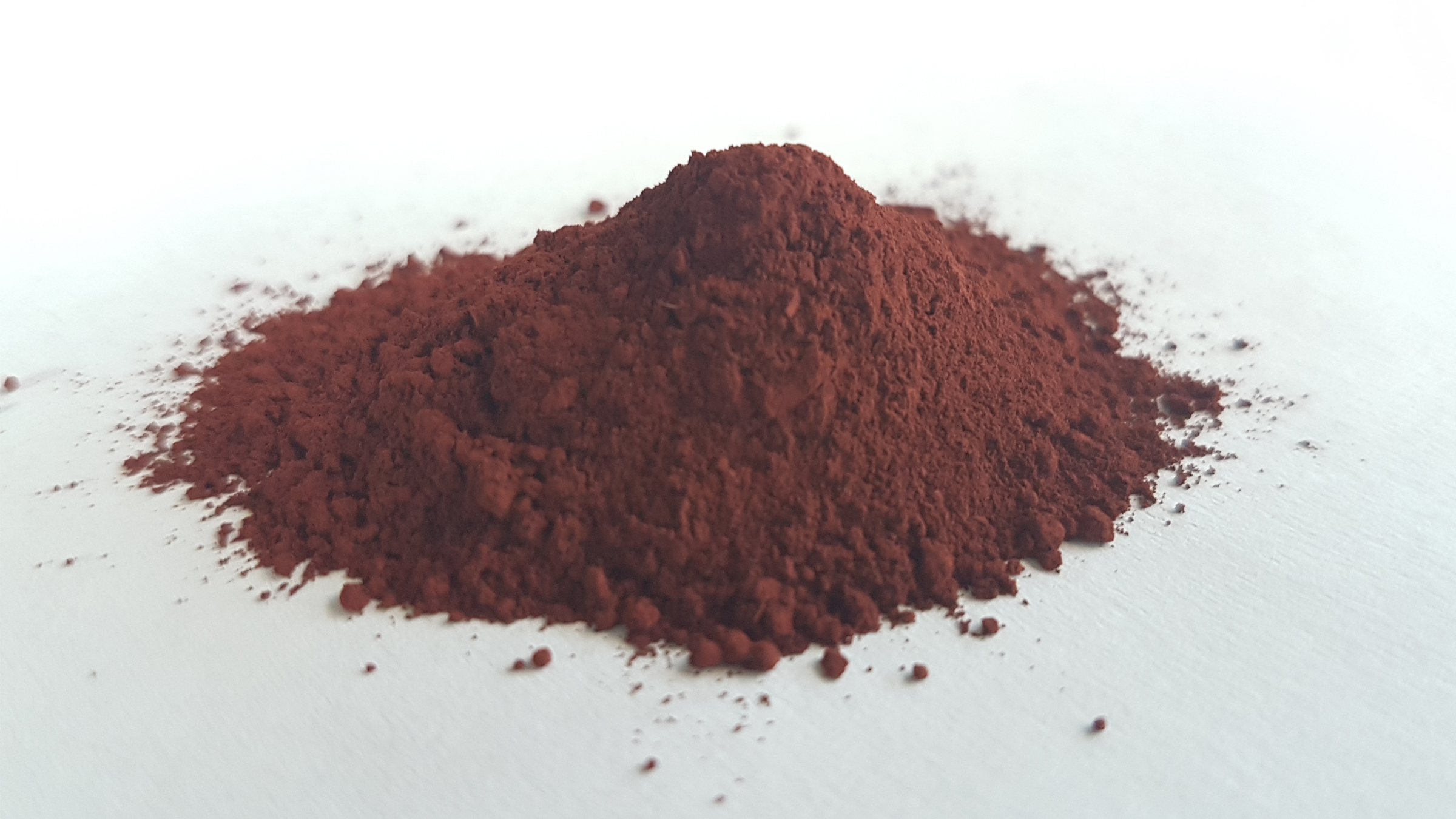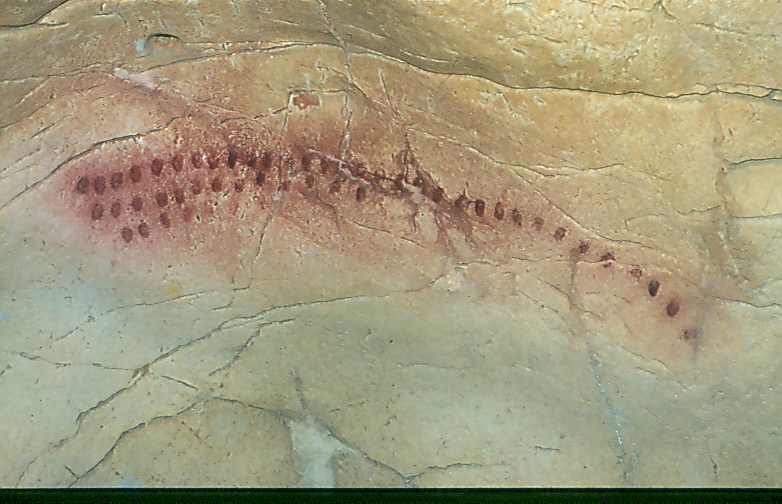Ocher: The world's first red paint
Ocher is found at ancient sites the world over.

Artists have been painting with ocher, a naturally occurring pigment, for hundreds of thousands of years. Their masterpieces range from prehistoric, ocher-pigmented images on cave walls to paintings on canvasses and other artwork from medieval times and onward.
Ocher (also spelled ochre and pronounced OAK-er) is clay pigmented by hematite, a reddish mineral that contains oxidized iron, which is iron that's been mixed with oxygen, said Paul Pettitt, a professor of paleolithic archaeology at Durham University in the United Kingdom.
Because ocher is a mineral, it doesn't wash away or decay, allowing it to persist through the ages. "Its vibrant color and ability to adhere to surfaces — including the human body — make it an ideal crayon or paint base," said April Nowell, a paleolithic archaeologist and professor and chair at the Department of Anthropology at the University of Victoria in Canada.
Related: The color of blood: Here are nature's reddest reds (photos)
Where is ocher found?
Ocher occurs naturally in rocks and soil — essentially in any environment where iron minerals have pooled and formed, Pettitt said. "It can be found in valley edges, eroding out of cliffs [or even] in caves eroding out of the bedrock," Pettitt told Live Science. In its more eroded form, ocher can be found in certain soils and then sieved out.
"It's actually very easy to obtain," Pettitt said. "Anybody who is using caves or operating in and around valleys will quite easily discover ocher."
People who pick up ocher will notice that it stains their hands a "nice red or yellow color," Pettitt noted. Once collected, ocher can easily be grated against a coarse piece of stone or ground by a mortar and pestle and then turned into a powder. Then, this powder can be mixed with a liquid, such as water, saliva or egg whites, and turned into pigmented paint.
Get the world’s most fascinating discoveries delivered straight to your inbox.
Ocher can also be used as a crayon. "It is very pliable," Pettitt said. "You can break it into small lumps."

Ocher's history
The earliest evidence of ancient humans using ocher dates to the Paleolithic, about 285,000 years ago, at a Homo erectus site called GnJh-03 in Kenya. There, archaeologists found about 70 pieces of ocher weighing about 11 pounds (5 kilograms).
However, more convincing evidence dates to about 250,000 years ago at the early Neanderthal site of Maastricht-Belvédère in the Netherlands, Pettitt said. During the 1980s, archaeologists in the Netherlands excavated small concentrates of the reddish mineral, according to a 2012 study in the journal Proceedings of the National Academy of Sciences. The Neanderthals may have powdered the ocher and mixed it with water so that they could paint their skin or clothing, Pettitt said.
Archaeologists have found a number of other Neanderthal ocher paintings in caves. These include linear fingerprint patterns in La Pasiega, in northern Spain; a hand stencil in Maltravieso, in west-central Spain; and red-painted stalactites that were originally sparkling white in Ardales, in northern Spain — all of which date to at least 64,000 years ago, according to a 2018 study in the journal Science.
However, the dating of the ancient ocher in Spain may not be accurate, said Lawrence Straus, a distinguished professor emeritus of anthropology at the University of New Mexico. And while it's possible that Neanderthals used ocher to make lines and dots — that is, non-representational paintings — it's debatable whether they actually made complex cave paintings, such as illustrations of animals or human figures, Straus said.
Early Homo sapiens also illustrated with ocher. At Blombos Cave, in South Africa, archaeologists found an abalone shell containing finely ground ocher, charcoal and fat that may have made up a painting kit dating to about 100,000 years ago, Nowell said. The earliest human-made drawing is a red hashtag on small rock flake that dates to about 73,000 years ago, also at Blombos Cave.
Meanwhile, the oldest drawing is an image of a warty pig created with ocher on a cave wall in Sulawesi, Indonesia, dating to about 51,200 years old.
Related: Photos: Oldest known drawing was made with a red crayon
After the time of these early sites, ocher paintings became more widespread, reaching Africa, Europe, the Middle East, Southeast Asia, Russia and Australia. When people crossed over the Bering Strait land bridge from Siberia and East Asia to the Americas, those people also used ocher, as evidenced by a burial covered in ocher in Alaska dating to about 11,500 years ago.
It's relatively common to find ocher-covered burials. It's likely that ocher colored the deceased's clothing, but as the clothing decayed, the ocher stained the grave and bones red, Pettitt said. One of these graves includes the famous Red Lady of Paviland in South Wales, in the United Kingdom, which is actually the burial of a young man who lived during the Paleolithic about 33,000 years ago. But when the burial was found in 1823, archaeologists thought that the stained-red grave must contain the remains of some sort of indecent, scarlet woman, Pettitt said.
Ocher continued to be used as a pigment throughout antiquity and was even used by artists in medieval times and the Renaissance, as well as in modern times, Pettitt said.
Ocher's uses and symbols
As a bright red pigment, it's possible that ancient people saw ocher as a symbol of life, in part because it is the color of blood, especially deep-red menstrual blood. "Some societies quite commonly associate the color red, and therefore ocher, with creation, life and fertility," Pettitt said. (However, not everyone agrees. See more below.)
Moreover, red is a striking color that's easy to see, especially in the low-light setting of a cave, Pettitt said.
Other than serving as paint, ocher had plenty of uses. People used it to tan hides, as mosquito repellent, for protection against the sun or cold, for medicinal purposes, for use in the extraction or processing of plants, and as an adhesive, such as attaching handles to stone tools, Nowell told Live Science in an email.
In art, "there is evidence that early peoples preferred certain colors," Nowell said.
For example, at the site of Qafzeh in Israel, archaeologists have found 84 lumps of ocher on layers dating between 100,000 and 90,000 years ago. About 95% of those lumps are red, even though yellow and brown ocher were also found in the area, she said. There's also evidence that ancient people heated ocher to turn it red. This may mean that early humans had a basic understanding of ocher's chemical properties, according to research by Francesco d'Errico, a professor of archaeology at the University of Bordeaux in France, Nowell said.
Related: Photos: 2 paleolithic boys were buried with fox teeth and spears
In addition, about 266,000 years ago, early hominins at a site called Twin Rivers in Zambia collected a type of hematite that has reflective metallic flakes in it, which make it glitter.
With those finds taken together, "to me, it is very possible that, initially, ocher was used for some mundane purpose, but over time, it took on a symbolic dimension," Nowell said. "I think the evidence for heat treating and preferential color selection and the addition of 'glitter' to some of their pigment paints, as well as the inclusion of vast amounts of ocher in burials (at some times and places) suggests to me that ocher's vibrant color(s) had a visual salience for Upper Paleolithic peoples."
It's hard to say if ocher symbolized menstruation, because there is no evidence for that, she said
"What we can say, following colleagues like Steve Kuhn [a professor of anthropology at the University of Arizona], is that it is likely that ocher was a simple way of marking a body (living or dead) and that information about group membership or status or any number of other variables could be communicated easily and cheaply," Nowell said. "The fact that ocher stains easily and lasts for a very long time (and mixes well into paint) likely are other reasons why it was used a lot."
Additional resources:
- Read more about ocher's use through history at ThoughtCo.
- Get the definition of ocher at Encyclopedia Britannica.
- Learn more about prehistoric pigments at the Royal Society of Chemistry.
Originally published on Live Science.

Laura is the managing editor at Live Science. She also runs the archaeology section and the Life's Little Mysteries series. Her work has appeared in The New York Times, Scholastic, Popular Science and Spectrum, a site on autism research. She has won multiple awards from the Society of Professional Journalists and the Washington Newspaper Publishers Association for her reporting at a weekly newspaper near Seattle. Laura holds a bachelor's degree in English literature and psychology from Washington University in St. Louis and a master's degree in science writing from NYU.



